Page 41 of 580
41
1-1. Hybrid system
1
Before driving
NOTICE
■
Hybrid battery air vent
●Do not put foreign objects over the air vent. The hybrid battery (traction
battery) may overheat and be damaged.
● Clean the air vent regularly to prevent the hybrid battery (traction battery)
from overheating.
● Do not wet the air vent. It may cause a short circuit and damage the hybrid
battery (traction battery).
● Do not load a large amount of water such as water cooler into the vehicle.
If water spills over the hybrid battery (traction battery), the battery may be
damaged.
Page 171 of 580
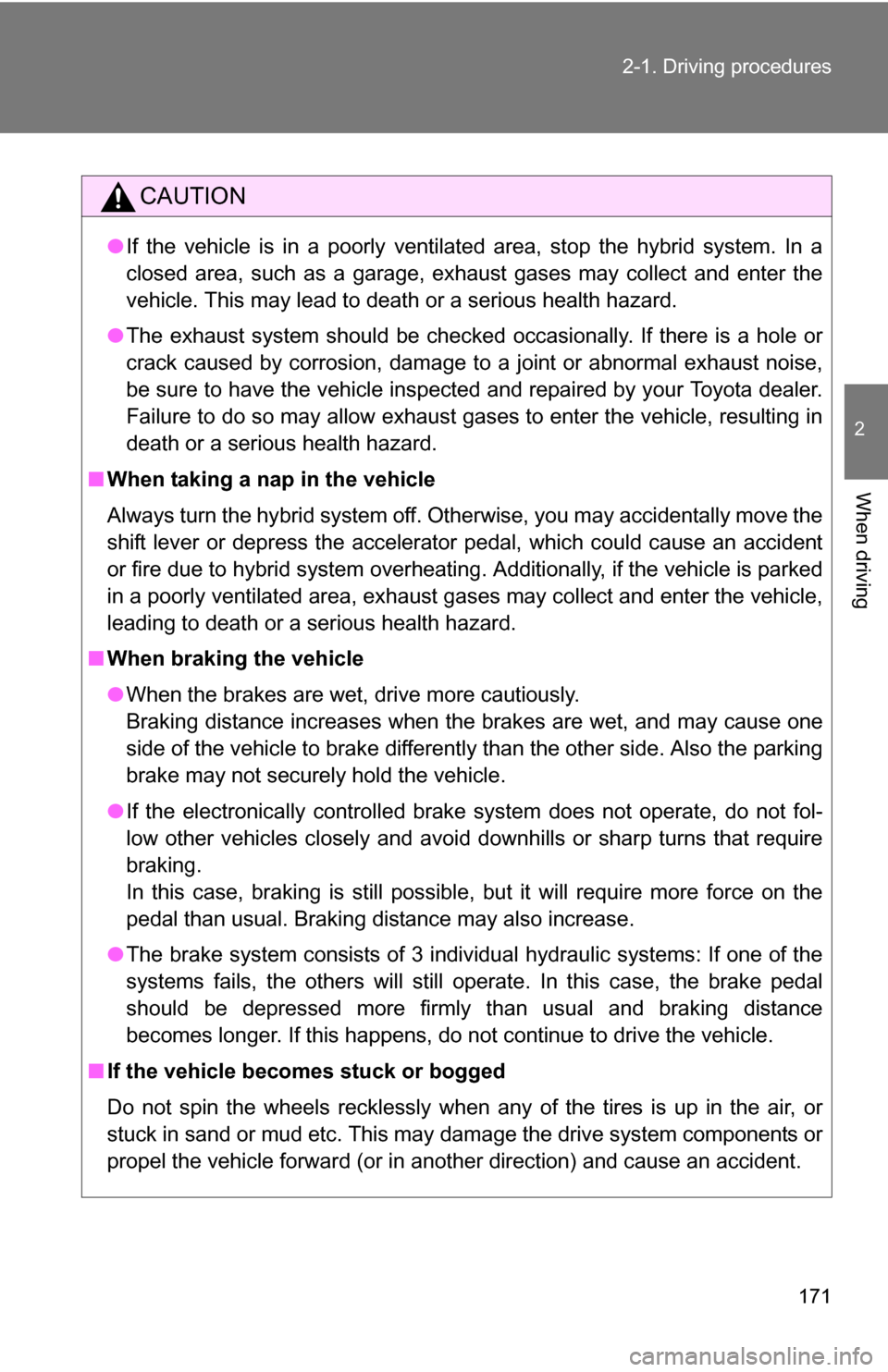
171
2-1. Driving procedures
2
When driving
CAUTION
●
If the vehicle is in a poorly ventilated area, stop the hybrid system. In a
closed area, such as a garage, exhaust gases may collect and enter the
vehicle. This may lead to death or a serious health hazard.
● The exhaust system should be checked occasionally. If there is a hole or
crack caused by corrosion, damage to a joint or abnormal exhaust noise,
be sure to have the vehicle inspected and repaired by your Toyota dealer.
Failure to do so may allow exhaust gases to enter the vehicle, resulting in
death or a serious health hazard.
■ When taking a nap in the vehicle
Always turn the hybrid system off. Otherwise, you may accidentally move the
shift lever or depress the accelerator pedal, which could cause an accident
or fire due to hybrid system overheating. Additionally, if the vehicle is parked
in a poorly ventilated area, exhaust gases may collect and enter the vehicle,
leading to death or a serious health hazard.
■ When braking the vehicle
●When the brakes are wet, drive more cautiously.
Braking distance increases when the brakes are wet, and may cause one
side of the vehicle to brake differently than the other side. Also the parking
brake may not securely hold the vehicle.
● If the electronically controlled brake system does not operate, do not fol-
low other vehicles closely and avoid downhills or sharp turns that require
braking.
In this case, braking is still possible, but it will require more force on the
pedal than usual. Braking distance may also increase.
● The brake system consists of 3 individual hydraulic systems: If one of the
systems fails, the others will still operate. In this case, the brake pedal
should be depressed more firmly than usual and braking distance
becomes longer. If this happens, do not continue to drive the vehicle.
■ If the vehicle becomes stuck or bogged
Do not spin the wheels recklessly when any of the tires is up in the air, or
stuck in sand or mud etc. This may damage the drive system components or
propel the vehicle forward (or in another direction) and cause an accident.
Page 183 of 580
183
2-1. Driving procedures
2
When driving
Parking brake
NOTICE
■Before driving
Fully release the parking brake.
Driving the vehicle with the parking brake set will lead to brake components
overheating, which may affect braking performance and increase brake
wear.
Sets the parking brake*
(Depress the pedal again
releases the parking brake.)
*: Fully depress the parking
brake pedal with your left
foot while depressing the
brake pedal with your right
foot.
U.S.A. Canada
Page 185 of 580
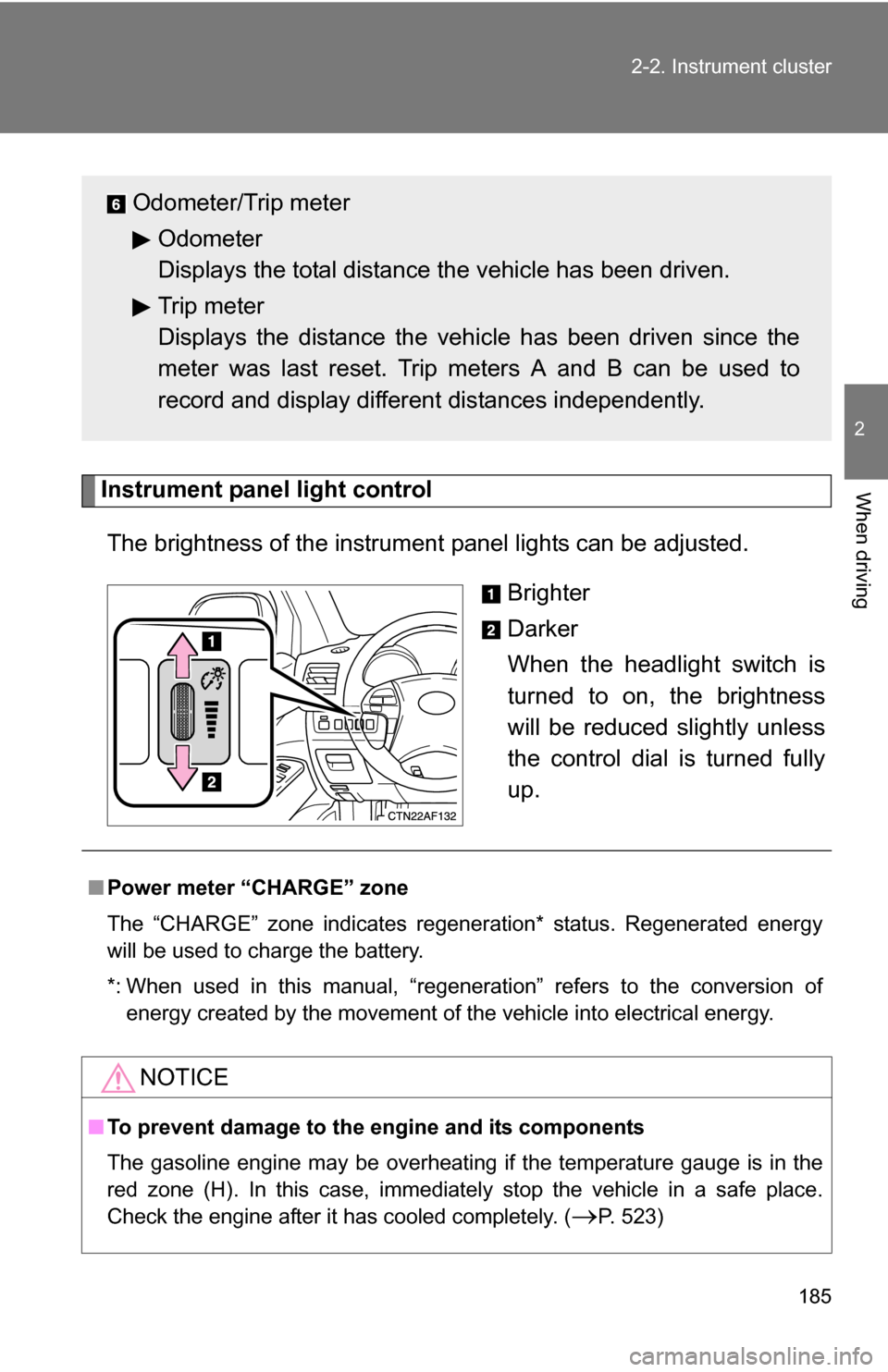
185
2-2. Instrument cluster
2
When drivingInstrument panel light control
The brightness of the instrument panel lights can be adjusted.
Brighter
Darker
When the headlight switch is
turned to on, the brightness
will be reduced slightly unless
the control dial is turned fully
up.
Odometer/Trip meterOdometer
Displays the total distance the vehicle has been driven.
Trip meter
Displays the distance the vehi cle has been driven since the
meter was last reset. Trip meters A and B can be used to
record and display different distances independently.
■ Power meter “CHARGE” zone
The “CHARGE” zone indicates regeneration* status. Regenerated energy
will be used to charge the battery.
*: When used in this manual, “regeneration” refers to the conversion of
energy created by the movement of the vehicle into electrical energy.
NOTICE
■To prevent damage to the engine and its components
The gasoline engine may be overheating if the temperature gauge is in the
red zone (H). In this case, immediately stop the vehicle in a safe place.
Check the engine after it has cooled completely. (
P. 523)
Page 217 of 580
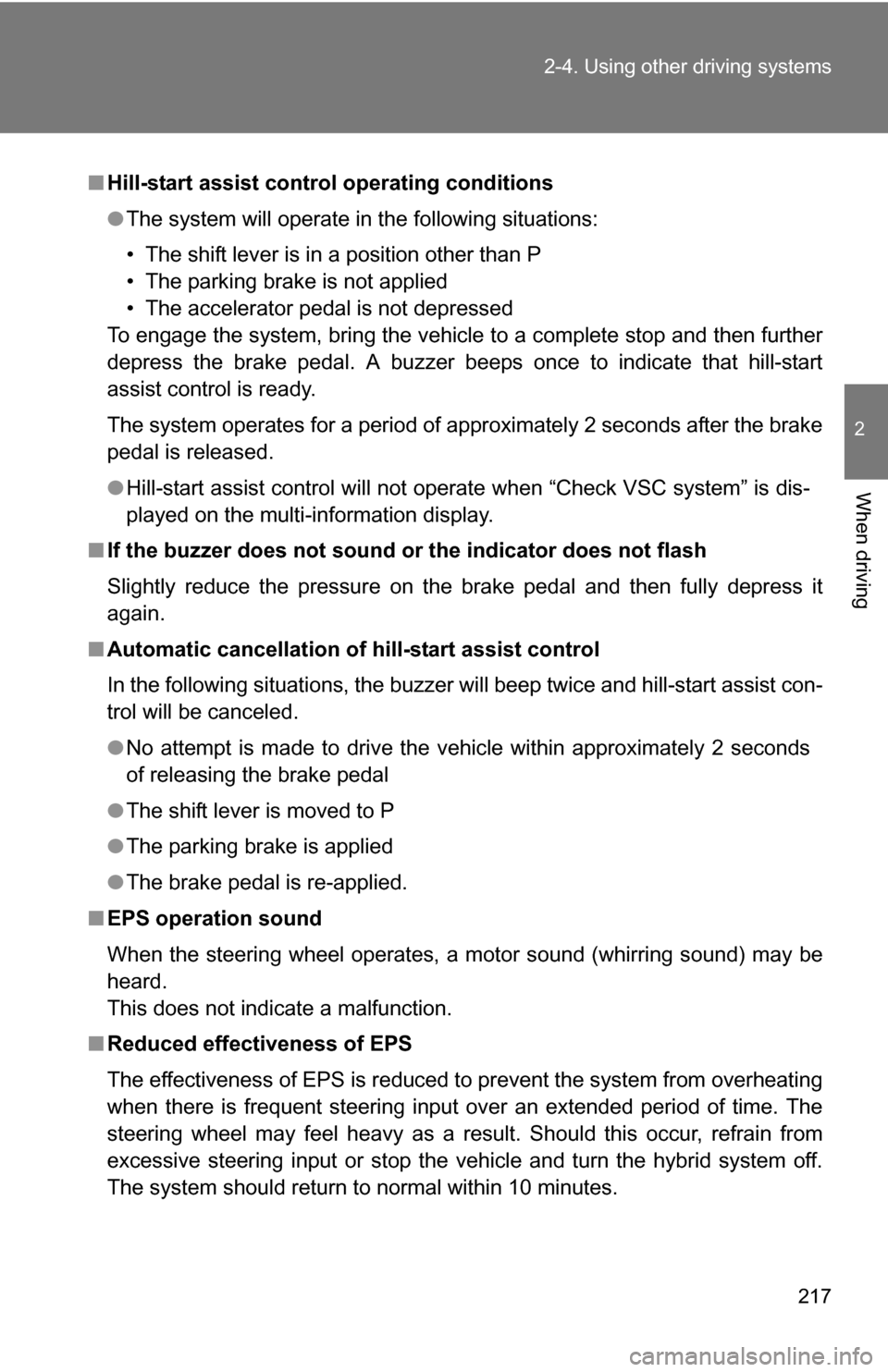
217
2-4. Using other
driving systems
2
When driving
■Hill-start assist control operating conditions
●The system will operate in the following situations:
• The shift lever is in a position other than P
• The parking brake is not applied
• The accelerator pedal is not depressed
To engage the system, bring the vehicle to a complete stop and then further
depress the brake pedal. A buzzer beeps once to indicate that hill-start
assist control is ready.
The system operates for a period of approximately 2 seconds after the brake
pedal is released.
● Hill-start assist control will not operate when “Check VSC system” is dis-
played on the multi-information display.
■ If the buzzer does not sound or the indicator does not flash
Slightly reduce the pressure on the brake pedal and then fully depress it
again.
■ Automatic cancellation of hill-start assist control
In the following situations, the buzzer will beep twice and hill-start assist con-
trol will be canceled.
●No attempt is made to drive the vehicle within approximately 2 seconds
of releasing the brake pedal
● The shift lever is moved to P
● The parking brake is applied
● The brake pedal is re-applied.
■ EPS operation sound
When the steering wheel operates, a motor sound (whirring sound) may be
heard.
This does not indicate a malfunction.
■ Reduced effectiveness of EPS
The effectiveness of EPS is reduced to prevent the system from overheating
when there is frequent steering input over an extended period of time. The
steering wheel may feel heavy as a result. Should this occur, refrain from
excessive steering input or stop the vehicle and turn the hybrid system off.
The system should return to normal within 10 minutes.
Page 385 of 580
385
3-7. Other interior features
3
Interior features
CAUTION
■
Burns
●Use caution when seating the following persons in a seat with the seat
heater on to avoid the possibility of burns:
• Babies, small children, the elderly, the sick and the disabled
• Persons with sensitive skin
• Persons who are fatigued
• Persons who have taken alcohol or drugs that induce sleep (sleeping
drugs, cold remedies, etc.)
● Do not cover the seat with anything when using the seat heater.
Using the seat heater with a blanket or cushion increases the temperature
of the seat and may lead to overheating.
NOTICE
■To prevent seat heater damage
Do not put unevenly weighted objects on the seat and do not stick sharp
objects (needles, nails, etc.) into the seat.
■ To prevent 12-volt battery from being discharge
Turn the switches off when the hybrid system is off.
Page 523 of 580
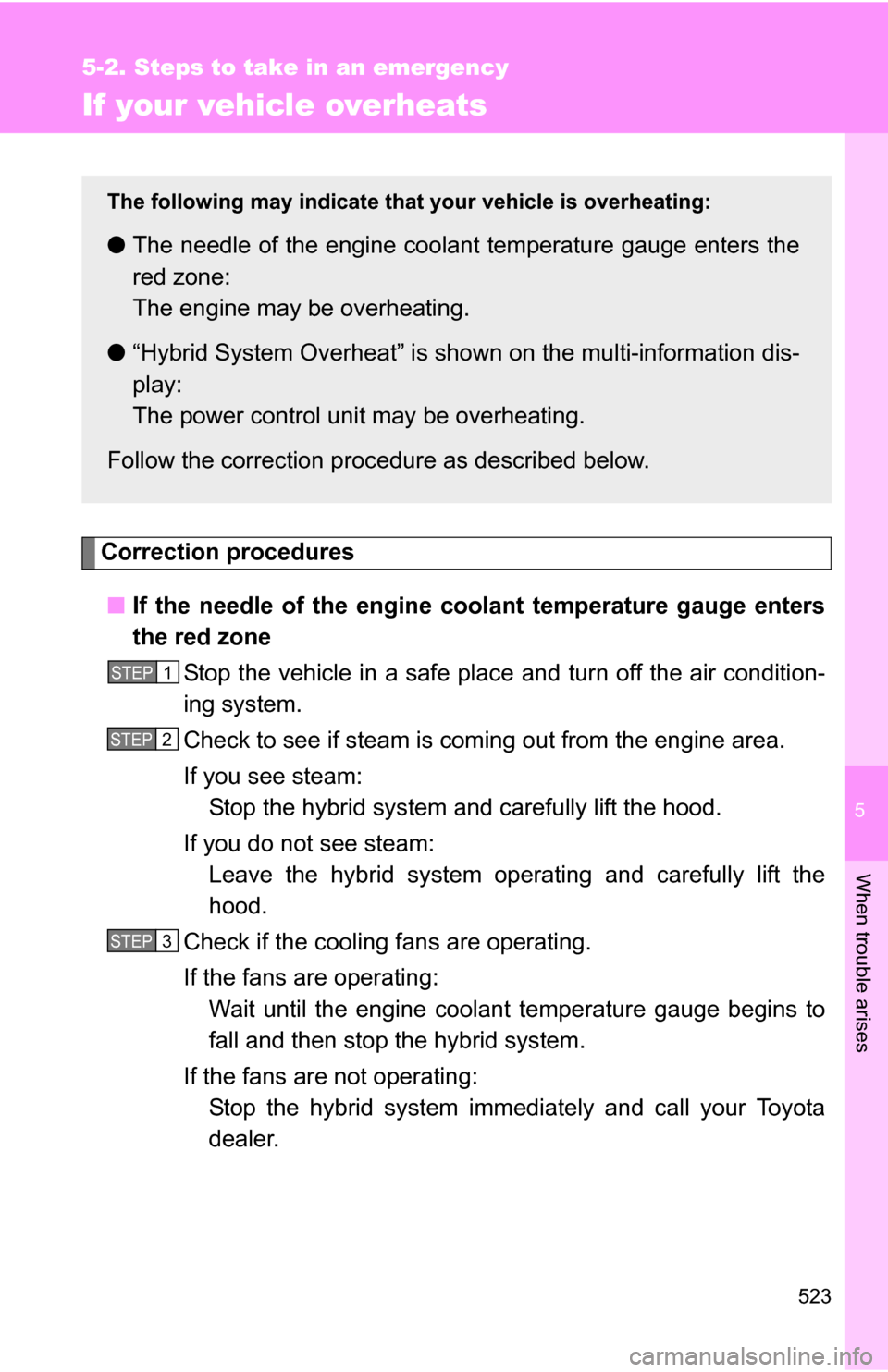
5
When trouble arises
523
5-2. Steps to take in an emergency
If your vehicle overheats
Correction procedures■ If the needle of the engine coolant temperature gauge enters
the red zone
Stop the vehicle in a safe place and turn off the air condition-
ing system.
Check to see if steam is coming out from the engine area.
If you see steam:
Stop the hybrid system and carefully lift the hood.
If you do not see steam: Leave the hybrid system operating and carefully lift the
hood.
Check if the cooling fans are operating.
If the fans are operating: Wait until the engine coolant temperature gauge begins to
fall and then stop the hybrid system.
If the fans are not operating: Stop the hybrid system immediately and call your Toyota
dealer.
The following may indicate that your vehicle is overheating:
●The needle of the engine coolant temperature gauge enters the
red zone:
The engine may be overheating.
● “Hybrid System Overheat” is shown on the multi-information dis-
play:
The power control unit may be overheating.
Follow the correction procedure as described below.
STEP1
STEP2
STEP3
Page 526 of 580
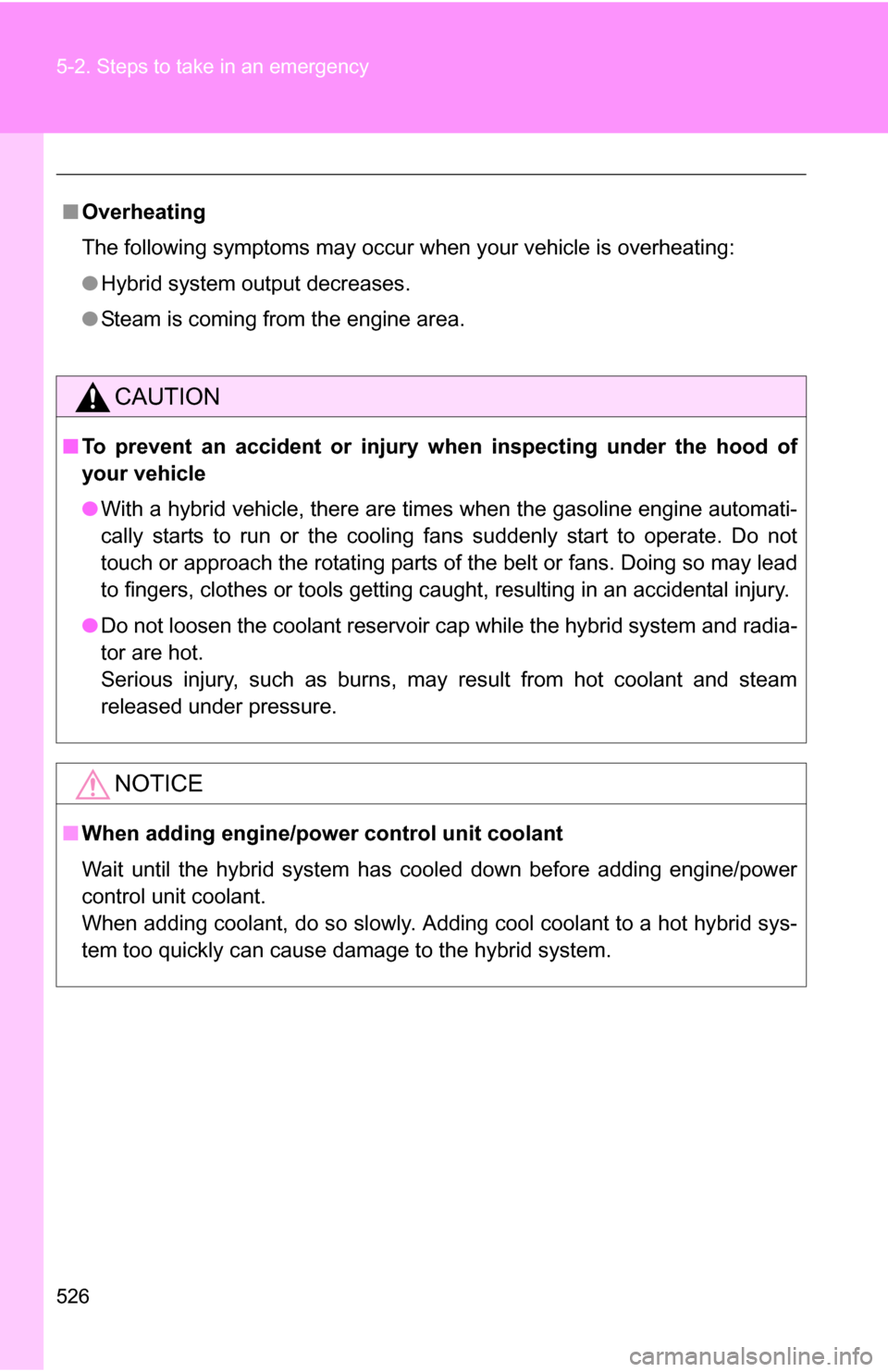
526 5-2. Steps to take in an emergency
■Overheating
The following symptoms may occur when your vehicle is overheating:
●Hybrid system output decreases.
● Steam is coming from the engine area.
CAUTION
■To prevent an accident or injury when inspecting under the hood of
your vehicle
● With a hybrid vehicle, there are times when the gasoline engine automati-
cally starts to run or the cooling fans suddenly start to operate. Do not
touch or approach the rotating parts of the belt or fans. Doing so may lead
to fingers, clothes or tools getting caught, resulting in an accidental injury.
● Do not loosen the coolant reservoir cap while the hybrid system and radia-
tor are hot.
Serious injury, such as burns, may result from hot coolant and steam
released under pressure.
NOTICE
■When adding engine/power control unit coolant
Wait until the hybrid system has cooled down before adding engine/power
control unit coolant.
When adding coolant, do so slowly. Adding cool coolant to a hot hybrid sys-
tem too quickly can cause damage to the hybrid system.